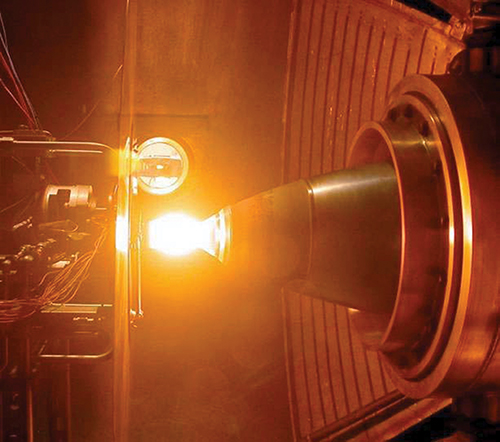
Materials Advance Chemical Propulsion Technology
NASA Technology
In the future, the Planetary Science Division of NASA’s Science Mission Directorate hopes to use better-performing and lower-cost propulsion systems to send rovers, probes, and observers to places like Mars, Jupiter, and Saturn. For such purposes, a new propulsion technology called the Advanced Materials Bipropellant Rocket (AMBR) was developed under NASA’s In-Space Propulsion Technology (ISPT) project, located at Glenn Research Center. As an advanced chemical propulsion system, AMBR uses nitrogen tetroxide oxidizer and hydrazine fuel to propel a spacecraft. Based on current research and development efforts, the technology shows great promise for increasing engine operation and engine lifespan, as well as lowering manufacturing costs.
In developing AMBR, ISPT has several goals: to decrease the time it takes for a spacecraft to travel to its destination, reduce the cost of making the propulsion system, and lessen the weight of the propulsion system. If goals like these are met, it could result in greater capabilities for in-space science investigations. For example, if the amount (and weight) of propellant required on a spacecraft is reduced, more scientific instruments (and weight) could be added to the spacecraft.
To achieve AMBR’s maximum potential performance, the engine needed to be capable of operating at extremely high temperatures and pressure. To this end, ISPT required engine chambers made of iridium-coated rhenium (strong, high-temperature metallic elements) that allowed operation at temperatures close to 4,000 °F. In addition, ISPT needed an advanced manufacturing technique for better coating methods to increase the strength of the engine chamber without increasing the costs of fabricating the chamber.
Partnership
In 2006, NASA’s ISTP project partnered with NASA’s Marshall Space Flight Center and Aerojet through a NASA Research Announcement (NRA) to increase AMBR’s performance efficiency and to lower the fabrication cost for the iridium-coated rhenium combustion chamber. Aerojet subcontracted a company in Huntsville, Alabama, called Plasma Processes Inc. (PPI) to modify a state-of-the-art engine design so the chamber wall materials could operate at very high temperatures.
While Aerojet defined the design details of the chamber configuration and worked with PPI to ensure the processes were in place to fabricate the chamber, the actual fabrication of the chamber was completed by PPI, using a process called EL-Form. Results from performance testing of the technology in 2008 and 2009 showed the propellant efficiency was higher than ever achieved for the hydrazine and nitrogen tetroxide oxidizer propellant combination. The iridium-coated rhenium chamber produced under the NRA set a hydrazine record for performance efficiency, which will mean a reduction in the propellant required to perform spacecraft maneuvers. It also had a 30-percent improvement on production costs.
“EL-Form allows us to deposit a thicker iridium layer for improved oxidation protection. It also allows us to produce the rhenium layer with better consistency and properties than what they had been doing in the past. The iridium rhenium chambers were in use already, but the El-Form process allows us to be able to improve those materials—affecting the quality and the cost,” says Anatoliy Shchetkovskiy, EL-Form director for PPI.
The iridium-coated rhenium combustion chamber fabricated using the EL-Form process addressed the needs of the ISTP project, as well as validated PPI’s process for making high-temperature materials for other applications.
Benefits
Compared to other coating processes, PPI’s EL-Form, or electroforming, process can reduce fabrication costs for iridium-coated rhenium material systems. Compared to traditional chemical vapor deposition processing techniques, the EL-Form process can produce thicker iridium layers for improved oxidation resistance, as well as perform multi-component processing.
PPI is the only supplier of the EL-Form process for electrodeposition of rhenium and other refractory metal and platinum group material coatings to graphite and metallic substrates. As demonstrated through testing with NASA, the EL-Form process makes components more capable of surviving high-pressure and high-temperature propulsion environments, with the resulting material having the capability to withstand steady-state temperatures up to and exceeding 4,000 °F. After validating the EL-Form process to fabricate high-temperature materials for NASA, PPI now uses the technique to make the same materials for other high temperature applications.
For example, PPI used EL-Form to create a coating with the same metal combination as the one used in the AMBR chamber for small thrust chambers for satellites. “The customer used it for advanced propellant, and the in-flight tests show it was successful,” says Shchetkovskiy.
In addition, the NASA-tested materials created by EL-Form have space propulsion rocket applications relevant to the commercial aerospace community, including Boeing, Honeywell, Alliant Techsystems Inc., and SpaceX. The U.S. Department of Defense, Navy, Air Force, and others are also using the high performance, low-cost iridium-coated rhenium material.
As the development of AMBR continues, PPI and Aerojet continue to work with Glenn through a Small Business Innovation Research (SBIR) contract to improve the room-temperature yield strength of the iridium-lined rhenium combustion chambers. Such innovation could mean even more benefits for propulsion technology processes and materials in the future.
EL-Form™ is a trademark of Plasma Processes Inc.

When NASA, Aerojet, and Plasma Processes Inc. tested AMBR, the results showed the chamber wall materials could withstand temperatures up to and exceeding 4,000 ?F. The same materials are now being used for high-temperature applications such as small thrust chambers for satellites.

The Cassini-Huygens spacecraft captured this view of Saturn in 2009. In order to send new rovers, probes, and observers to Mars, Jupiter, and Saturn, NASA is working with industry to develop propulsion technologies such as the Advanced Material Bipropellant Rocket (AMBR).













